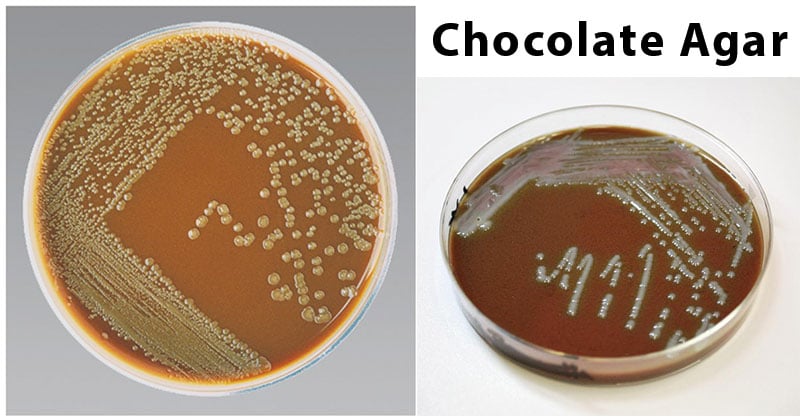Chocolate agar is essentially the same as blood agar except that during preparation the red blood cells are lysed when added to molten agar base. As a result, the cell lysis releases intracellular nutrients such as hemoglobin, hemin (“X” factor), and the coenzyme nicotinamide adenine dinucleotide (NAD or “V” factor) into the agar which is utilized by fastidious bacteria. Red blood cell lysis gives the medium a chocolate-brown coloration when prepared from which the agar gets its name. The most common bacterial pathogens that require this enriched medium for growth include Neisseria gonorrhoeae and Haemophilus species.

Interesting Science Videos
Composition of Chocolate Agar
| Ingredients | Gms /L |
| Casein/Animal Tissue Digest | 15.0g |
| Cornstarch | 1.0g |
| Sodium chloride | 5.0g |
| Dipotassium Phosphate | 4.0g |
| Monopotassium Phosphate | 1.0g |
| Hemoglobin solution | 2% |
| Koenzyme enrichment | 10.0ml |
| Agar | 10.0g |
Final pH 7.2 ± 0.2 (at 25°C)
Principle of Chocolate Agar
Chocolate Agar Base, with the addition of supplements, gives excellent growth of the fastidious organisms without overgrowth by contaminating organisms. Casein and animal tissue digest that provides the organism with nitrogenous nutrients, amino acids, and other elements essential for the growth of the organisms. As Neisseria species are highly sensitive to toxic substances such as fatty acids, hence the addition of cornstarch helps neutralize possible toxic metabolites, while potassium phosphate helps maintain a uniform pH during growth. Sodium chloride maintains osmotic equilibrium thereby maintaining the integrity of cells. Chocolate agar is also considered as a variant of the blood agar plate, containing red blood cells that have been lysed by slowly heating to 80°C. The heat inactivates enzymes that could otherwise degrade NAD. The added supplements provide the necessary X factor (from Haemoglobin) and V factor (from Growth Supplement) required by the fastidious organisms.
Some modifications can also be made for the growth of the specific organism. Thayer-Martin Media is a chocolate agar supplemented with vancomycin, nystatin, and colistin to inhibit the normal flora, including nonpathogenic Neisseria for the selective isolation of N. gonorrhoeae and N. meningitidis. Chocolate Agar supplemented with bacitracin is a selective medium used to improve the primary isolation of H. influenzae from specimens containing a mixed flora of bacteria and/or fungi. Chocolate agar supplemented with GC base and growth supplement is another modification that supports the special growth requirements (hemin and NAD) needed for the isolation of fastidious organisms, such as H. influenzae when incubated at 35-37°C in a 5% CO2 atmosphere.
Preparation of Chocolate Agar
Preparation of the hemoglobin solution
Add hemoglobin to distilled water and bring volume to 500 ml. Mix thoroughly and autoclave for 15 min at 15lbs pressure at 21°C. Cool at 45°C -50°C.
Preparation of medium
Add components except for hemoglobin solution to distilled water and bring volume to 500ml. Mix thoroughly. Gently heat until boiling. Autoclave for 15 min at 15lbs pressure at 21°C. Cool at 45°C -50°C. Add 500ml of sterile hemoglobin solution and mix thoroughly. Pour into sterile Petri dishes or distribute into sterile tubes.
Result Interpretation of Chocolate Agar
- Neisseria gonorrhoeae produces small, grey to white, mucoid colonies, smooth consistency, and defined margins.
- Neisseria meningitidis produces larger bluish-grey, mucoid, round, convex, smooth, moist, glistening colonies with a clearly defined edge.
- Haemophilus influenzae produces small, colorless, moist colonies with a characteristic seminal odor.
Uses of Chocolate Agar
- It is used in the isolation and cultivation of fastidious microorganisms, particularly Haemophilus and Neisseria species.
- It is used for the isolation of Neisseria gonorrhoeae from chronic and acute cases of gonococcal infections.
Limitations of Chocolate Agar
- It is recommended that additional biochemical and/or serological tests should be performed on isolated colonies from the pure culture in order to complete identification.
- Chocolate Agar is an enriched medium, thus non-pathogenic organisms may overgrow pathogenic bacteria. If isolation of N. gonorrhoeae is desired, a selective medium such as Thayer Martin Agar, Modified should be used in parallel with this non-selective formula.
- Precipitated hemoglobin may appear as dark spots on or in the media and does not affect the performance of the media.
- The presence or absence of N. gonorrhoeae in a specimen does not rule out the possible presence of other pathogenic organisms.
References
- Dalynn Biologicals
- Northeast Laboratory Services
- Himedia
- Hardy Diagnostics
- Ronald M. Atlas and James W. Snyder. Handbook of media for clinical and public health microbiology. CRC Press. 2014 by Taylor & Francis Group, LLC.

In 45 _ 50 c we have blood agar not chocolate agar.